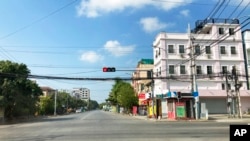A freelance photographer who died in military custody in Myanmar "wanted to show the world what was happening" in his home country, a friend has said.
Myanmar authorities detained Soe Naing on December 10 during a "silent strike" protest in Yangon against the military coup.
A few days later, family members were told he had died.
Naing is the first journalist to die in prison since the military seized power in February, ousting the elected government of Aung San Suu Kyi.
His death raised international condemnation and calls for an investigation. Friends and others close to Naing told Radio Free Asia they believed the photographer was beaten to death.
Myanmar's military government has not publicly commented on Naing's death. Its spokesperson did not respond to VOA's request for comment.
A friend of Naing's spoke with VOA about the journalist.
The friend, who currently lives in Singapore but who requested anonymity over safety concerns, met Naing at an exhibition in Myanmar several years ago.
A graphic designer by trade, Naing was a photo enthusiast. He didn't have a media pass, but he would give media outlets permission to use his work.
"He always wanted to take photos. He really wanted to show the world what was happening (in Myanmar)," the friend said.
The friend learned of details of Naing's movements up to his arrest through others who knew the journalist.
"On that day, he didn't even bring his camera — he used his mobile phone," the friend said. "In the morning, they met with friends, had some breakfast. (Afterward), they went downtown (Yangon). He was caught there."
Protests like the one Naing was covering have been a regular occurrence, with thousands refusing to recognize or accept military rule.
But such reporting is risky for media. The junta has detained dozens of journalists and revoked media licenses.
Safety fears
Naing's death in custody has raised international condemnation.
"We want the authorities to fully investigate this death and reiterate our call for the release of the journalists and government officials detained in the country," Farhan Haq, deputy spokesperson for United Nations Secretary-General Antonio Guterres, told VOA.
Media watchdog Reporters Without Borders (RSF) called for new targeted sanctions by the international community.
"With Soe Naing's death, a new tragic threshold has been crossed this morning in the terror that Myanmar's military are using against journalists," Daniel Bastard, head of RSF's Asia-Pacific desk, said in a December 14 statement.
Naing, who was approximately 40 years old, had a wife and child.
"He adored his son and wanted to help others," his friend said, adding that the coup angered Naing.
"After the military coup, he changed. … This kind of thing, he cannot accept this military coup. He would go and take photos nearly every day," the friend said.
Concerns for Naing's safety were raised when his Facebook account was disabled after he was detained. He was taken to a police station and an interrogation center.
"After three to four days, my friend sent me a message: 'He's dead,'" the friend said.
The news was a shock. At first, the friend did not believe what he'd heard. But others said Naing's family had received a call from the military hospital.
"Everybody just thought after a few days, he would be released or (sent) to Insein Prison. This kind of thing is not acceptable. He (was) just taking photos on the road," he said.
'Inhumane' prisons
Conditions inside Myanmar's prisons are said to be bleak. Former detainees and rights groups described torture, brutality and inhumane conditions.
Yuki Kitazumi, a Japanese journalist arrested in February and held at Insein Prison for a month, told VOA about the stories he had heard of torture.
"They were tortured in the military compound before they arrived at Insein Prison," Kitazumi said, adding that often an inmate would be hooded, with their hands cuffed behind their back, and then made to kneel."
Kitazumi said, "They continued interrogation for 24 hours on a day and continued on several days. No drink for two days, and no food for three days."
U.S. journalist Nathan Maung, who was also detained by the junta earlier this year, told VOA he was beaten and blindfolded.
'Anyone can be killed'
Maung, a U.S. citizen of Burmese descent, said Naing's death shows the extreme risks for media.
"Taking photos in the empty streets in order to show the world that people of Burma are in a 'silence strike'— it is enough for the military to kill," Maung said. "Anyone can be killed in the first three days in their hands. If not, you have survived."
Naing's death has worried the families of other detained journalists.
So far this month, the junta has detained Democratic Voice of Burma (DVB) reporter Aung San Lin on December 11 and local journalist Min Theik Tun on December 12. Freelance photographer Zaw Tun was detained the same day as Naing.
On Sunday, authorities detained freelance photojournalists Zaw Lin Htut and Su Yee Lin of the East Yangon University Students' Union, while they were in a bakery in a Yangon suburb.
A friend of Htut told VOA Burmese the pair were on their way to a solidarity protest. But five men took the pair away at gun point.
"So far, we do not know where they are being held or what their condition is," said the friend, who requested anonymity for safety concerns.
"In the aftermath of the arrest and detention of journalists, and in the case of Soe Naing, it is possible that the junta is deliberately persecuting, torturing and killing journalists. We are concerned about sexual violence against female detainees, as well," Htut's friend told VOA Burmese.
As of mid-December, Reporting ASEAN, a monitoring group for countries in Southeast Asia, shows 113 journalists or media workers arrested in 2021, with at least 42 still detained.
VOA Burmese contributed to this report.






